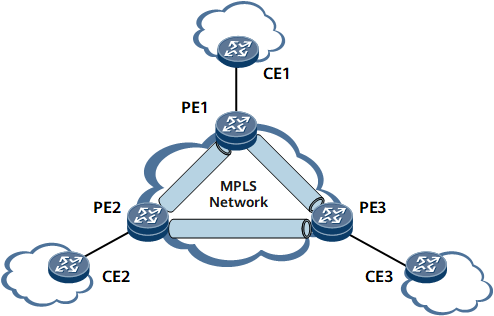Configuring BGP AD VPLS
BGP AD VPLS-enabled devices exchange extended BGP packets to automatically discover member VSIs in a VPLS domain and then use LDP FEC 129 to negotiate PW establishment to achieve automatic VPLS PW deployment.
Usage Scenario
As VPLS technologies are widely employed and VPLS networks increase in their scale, VPLS configurations on networks increase accordingly. To simplify network configurations and reduce carriers' operational expenditure (OpEx), BGP AD VPLS is used. It can achieve automatic service deployment.
BGP AD VPLS has the advantages of BGP VPLS and LDP VPLS. BGP AD VPLS-enabled devices exchange extended BGP packets to automatically discover member VSIs in a VPLS domain and then use LDP FEC 129 to negotiate PW establishment to achieve automatic VPLS PW deployment.
BGP AD VPLS also has the following advantages as compared with other VPLS configuration modes:
As shown in Table 1, BGP AD VPLS saves label resources on PEs. To establish PWs with each other, PEs use LDP signaling as PW establishment is quite complicated.
- As shown in Table 2, BGP AD VPLS uses existing BGP sessions to discover member VSIs in a VPLS domain when new nodes are added to VPLS domains or new VPLS domains are deployed. If member VSIs in a VPLS domain are discovered, BGP AD VPLS-enabled devices can automatically establish PWs with each other. This simplifies PW configurations on PEs.
With automatic VPLS member discovery and PW deployment, BGP AD VPLS simplifies VPLS network configuration, achieves automatic service deployment, and reduces carriers' OpEx.
VPLS Mode |
Advantage |
Disadvantage |
|---|---|---|
BGP VPLS |
|
|
BGP AD VPLS |
|
|
VPLS Mode |
VSI Configurations on New Nodes |
Additional Configurations on Existing Nodes |
|---|---|---|
LDP VPLS |
vsi-id company1 pwsignal ldp vsi-id 2 peer x.x.x.x ... |
vsi-id company1 pwsignal ldp vsi-id 2 peer y.y.y.y ...... |
BGP AD VPLS |
vsi-id company1 bgp-ad vpls-id 10 ... l2vpn-ad-family peer x.x.x.x enable |
No additional configurations need to be performed. BGP AD VPLS-enabled devices exchange extended BGP Update packets that carry VSI member information to automatically discover member VSIs in a VPLS domain and then use LDP FEC 129 signaling to negotiate and establish PWs between the member VSIs that are discovered. BGP AD VPLS allows automatic VSI member discovery and automatic VPLS PW deployment in VPLS domains. Therefore, existing VSIs do not need additional configuration. |
On the network shown in Figure 1, BGP sessions are established between PE1, PE2, and PE3, and BGP AD VPLS is configured on PE1 and PE2 that reside in the same VPLS domain. PE3 needs to be added to the VPLS domain for network expansion. To achieve this goal, configuring the ID of the VPLS domain for a VSI on PE3 is required. VPLS configurations do not need to be modified on BGP AD VPLS-enabled PE1 and PE2. After PE3 joins the domain, PWs can be automatically established using BGP AD VPLS between PE1 and PE3 and between PE2 and PE3. This simplifies VPLS configuration.
BGP AD also supports HVPLS. The pw spoke-mode command can be run to configure the PWs of BGP AD VSIs as spoke PWs. After the command is run, remote peers of a PE are used as user-side devices on an HVPLS network.
Pre-configuration Tasks
Before configuring BGP AD VPLS, complete the following tasks:
Configure IP addresses and routes on PEs and Ps to ensure that neighboring nodes are reachable at the network layer.
Configure LSR IDs and enable basic MPLS functions on PEs and Ps.
Establish tunnels between PEs to bear L2VPN services.
Enable MPLS L2VPN on PEs.
- Enabling BGP Peers to Exchange Route Information
- BGP peers need to be enabled to exchange route information in the L2VPN-AD address family view.
- Creating VSIs and Configuring BGP Signaling
- Before configuring BGP AD VPLS, you need to create a VSI and configure BGP AD signaling on a PE.
- Binding a VSI to an AC Interface
- Based on the type of link between a PE and a CE, a VSI and an AC interface are bound in various views.
- Verifying the BGP AD VPLS Configuration
- After completing BGP AD VPLS configurations, run the following commands to view information about the local and remote VSIs and VPLS connections.
